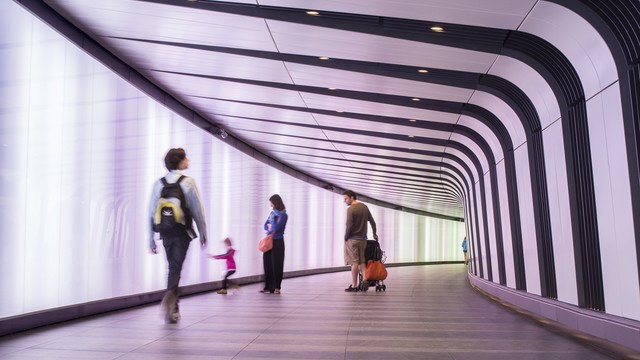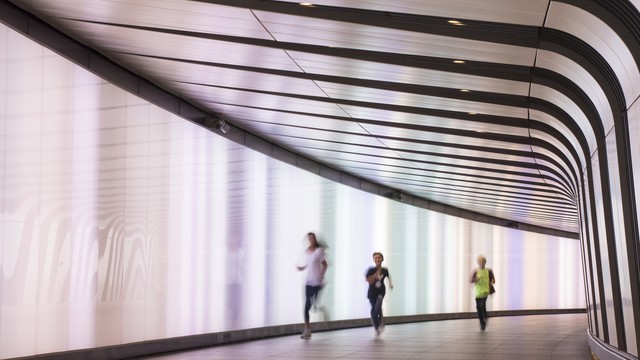Pipette 2014, United Kingdom, London
A tapestry of light



Pipette is an art piece comprised of an illuminated surface which evokes the colourful tapestry of Kings Cross, London, UK. It displays moving linear threads of colours of a range not regularly seen in LED systems - the weave of the tapestry continually shifts its pattern. It is a tranquil, animated piece located in the new subway entrance tunnel under One Pancras Square. The piece has been created with the commuter’s day-to-day experience in mind and to work in harmony with the existing lighting scheme as well as the architecture. The colours, light quality and animation of Pipette also showcase the tunnel’s potential for alternative uses.
A 90m long curved light artwall - the longest in Europe - has been created in a new pedestrian tunnel that connects King’s Cross St Pancras Underground station with the David Chipperfield Architect-designed One Pancras Square. Designed to enrich the pedestrian's experience, the artwall creates a memorable and immersive experience; one that gives the tunnel impact and marks it out as one of the main gateways to the site. The artwall runs the full length of the tunnel, activating the dramatic, triangular tunnel cladding and drawing pedestrians from the adjacent Tube tunnels. The wall provides a soft, seamless light effect, with the ability to produce both beautiful pastel shades as well as intense, saturated colour; all of which can be individually animated.The intention was to create an art installation that happens to use light as its primary medium. Artists Miriam Sleeman and Tom Sloan have created the first artwork content for the artwall. Entitled “Pipette”, it is designed to evoke the colourful tapestry of Kings Cross.
http://www.speirsandmajor.com/blog/article/entry_kings_cross_tunnel_opens_to_public/
miriamandtom.com/works/pipette
Details
Building or project owner : King’s Cross Central Limited Partnership (KCCLP)
Architecture : Allies and Morrison
Project artist/ concept/ design/ planning : Miriam Sleeman and Tom Sloan (for Content on light wall); Speirs & Major (for Conception of light wall)
Light design : Speirs & Major
Light hardware (LED hardware) : The Light Lab
Lighting control software : Pharos
Project co-ordination : King’s Cross Central Limited Partnership (KCCLP)
Interaction design/ programming : Miriam Sleeman and Tom Sloan, Control Lighting Ltd
Descriptions
Facade type and geometry (structure) : 2.5m high x 1.25m wide translucent white glass panes, invisibly joined together to create a continuous, 90m long curved wall surface.
Kind of light creation : Glass panes are backlit with individually controllable LED fittings capable of mixing and emitting the full RGB spectrum alongside a white light spectrum of 3.0K to 6.0K. The LED fittings distribute light evenly across the glazing, creating a soft and seamless curved appearance with no shadow lines throughout.
Resolution and transmitting behaviour : 370 2.5m high vertical LED fittings (each 48 Watts max) rear illuminate the glazing of the lightwall. Connected in pairs, 185 individually controllable full colour linear 'pixels' are created across the entire length and surface of the glazed wall. The LED fittings provides the ability to produce both beautiful pastel shades as well as intense, saturated colours; all of which can be animated.
Pixel distance : 50 centimeters
Luminace : Medium to low brightness. The illumination from the lightwall subtly augments the ceiling lights in the tunnel. The tunnel is open to pedestrians from Monday-Sunday, 7am until 8pm.
Urban situation : The art wall leads into one King’s Cross St Pancras Underground station, connecting the station to the entrance level of the David Chipperfield Architect-designed One Pancras Square.
Description of showreel : The light wall displays animated ranges of colours sampled from digital images of Kings Cross, hence the name 'pipette'. The colours gently order, shuffle and reorder themselves over the course of the day.